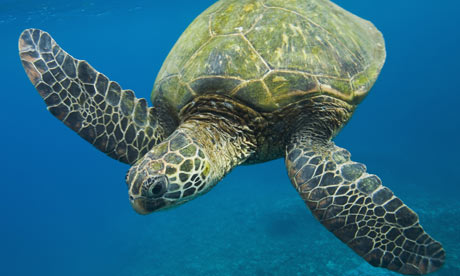Millions of sea turtles dying in fishing gear, report warns

An adult green sea turtle (Chelonia mydas). Though turtles are still hunted for their meat and shells, accidental entrapment is a greater threat. Photograph: Specialist Stock/Corbis
Tens of thousands of sea turtles were trapped and killed by commercial fishing fleets over the past 20 years, but real total could number millions. Millions of sea turtles have been inadvertently trapped and killed by commercial fishing fleets over the last 20 years, a global survey has found.
Six of the seven species of sea turtle are under threat. The study, published in Conservation Letters, said the biggest danger to their survival was being inadvertently caught up by commercial fishing gear - long lines which can stretch for up to 40kms studded with hooks or vast nets - to become what is known as bycatch. Once snared, the turtles are unable to come to the surface to breathe.
Although turtles, the second largest reptile species on Earth, are still hunted for their meat and shells, accidental entrapment is a greater threat.
“Bycatch, writ large, is the most serious, acute threat to the sea turtle population globally,” said Bryan Wallace, the lead author.
“Trawlers are completely indiscriminate. The target might be shrimp but for every pound of shrimp that might comp up with a given haul, there might have five or 20lbs of bycatch. That could be turtles, it could be all sorts of things,” said Wallace, a professor at Duke University and science adviser to Conservation International.
The study is the first global survey of commercial fishing operations, gauging the effects on sea turtles of three widely used methods of fishing gear: long lines, gillnets and trawls.
It reviewed existing records from fishing fleet operations around the world. All the data was based on direct onboard observations or interviews with fishermen.
According to those records, more than 85,000 turtles were snared between 1990 and 2008. But Wallace said the figure covered barely 1% of fishing operations, and did not cover smaller fleets. “A conservative estimate is that the true total is probably in the millions of turtles,” he said.
However, he said the adoption of different equipment - such as turtle excluder devices or escape hatches which allow turtles to swim free of large nets - could dramatically reduce the numbers of bycatch. Some countries have now made such precautions mandatory.
One of the report’s recommendations was for consumers to be conscious of where their fish was sourced.
The report also recommends seasonal bans on fishing to avoid turtle migration routes.
The report identified four regions where urgent conservation measures are needed: the Mediterranean, the eastern Pacific, and the south and north-west Atlantic off the coast of the United States. It said the crowded, heavily fished Mediterranean had some of the highest rates of bycatch because of heavy use of long lines and trawling. The coast off Mexico’s Baja Peninsula, a crucial nesting area for sea turtles, was also deadly.
According to the IUCN red list of endangered species, five species of sea turtle - hawksbill, leatherback, Kemp’s Ridley, green and loggerhead - are either endangered or critically endangered. The Olive Ridley is classed as vulnerable while flatback turtles are classed as “data deficient”, meaning there is not enough research to make a conservation assessment.
You can return to the main Market News page, or press the Back button on your browser.

